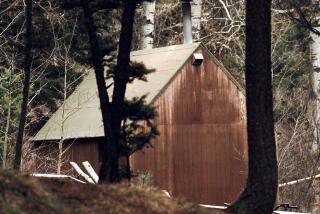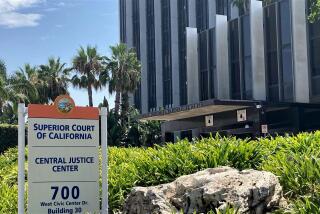Kaczynski Admits Guilt and Will Get Life Term
- Share via
SACRAMENTO — Admitting he is the elusive Unabomber, Theodore Kaczynski pleaded guilty Thursday to a nationwide crime spree that included three murders-by-bombing, ending his trial before it even began.
In turn, the federal government will not seek to execute the onetime UC Berkeley mathematics professor but will instead allow him to spend the rest of his life in prison without the possibility of release.
U.S. District Judge Garland E. Burrell set May 15 for formal sentencing of Kaczynski, 55, who Thursday dropped a series of conditions that for weeks had snagged plea negotiations.
What took nearly 20 years to unravel ended in a single afternoon, with Kaczynski, no longer a disheveled recluse but neatly attired and looking more like an academician, admitting to 13 federal charges covering five bombings by declaring calmly, “Guilty, Your Honor.”
“The Unabomber’s career is over,” a somber lead prosecutor Robert Cleary told a throng of reporters outside the federal courthouse in Sacramento after Kaczynski agreed to the dramatic plea bargain just as the trial was to start. “This is an important day for justice and for the victims.”
Cleary also hailed David Kaczynski, who tipped authorities to his older brother’s possible identity as the Unabomber, as “a true American hero” and cited the excruciating ordeal suffered by the upstate New York social worker since he contacted the FBI two years ago.
The younger brother may now be eligible for all or part of a $1-million FBI reward, a government source said. David Kaczynski has indicated that he would use the money to help victims of the blasts.
Outside the courthouse, the younger Kaczynski, who fought to spare his brother’s life, voiced “deep relief” at the settlement. “We feel it is the appropriate, just and civilized approach,” he told reporters.
Clasping the shoulder of his mother, 80-year-old Wanda, he also expressed the family’s condolences to the surviving victims, offering them “our deep sorrow and regrets.”
As the Unabomber--a name derived from his earliest targets, universities and airlines--Theodore Kaczynski frustrated investigators, focusing the nation’s attention on his mysterious spree. Starting in 1978, he mailed or placed his deadly packages, killing three people and injuring 29.
In Sacramento, he was charged in the deaths there of Hugh Scrutton, a local computer store owner, and Gilbert Murray, a timber industry executive. Kaczynski was also accused in the attacks that seriously injured UC San Francisco geneticist Charles Epstein, who watched in the courtroom Thursday, and Yale University computer scientist David Gelernter.
Kaczynski--who may be sent to a federal prison in Pleasanton, east of Oakland, while awaiting sentencing--admitted Thursday to being responsible for those attacks, along with the blast that killed New Jersey advertising executive Thomas Mosser.
Had Kaczynski been tried and convicted, he would have faced possible death by injection. Now, he may be heading for a life in a solitary cell in a maximum security prison, far away from the woods where he had lived for many years.
In recent weeks, interest in the increasingly chaotic case mounted as Kaczynski drew attention to himself, seeking to fire his legal team and possibly represent himself, and apparently trying to hang himself in jail with his underwear.
The suicide attempt prompted Burrell to order a government psychiatric evaluation. Although Kaczynski was found competent to stand trial, a psychiatrist reportedly determined that he is a paranoid schizophrenic.
Legal experts agreed that Dr. Sally Johnson’s conclusion probably helped ease the way for the government to strike the deal--though President Clinton had urged Wednesday that the case be allowed to go to the jury.
Brother, Mother Watch Tearfully
Inside the courtroom packed with spectators, David Kaczynski and his mother watched tearfully from the front row as Theodore forthrightly acknowledged a series of chilling crimes over an 18-year period.
“Yes, your Honor,” Kaczynski answered as prosecutor R. Stephen Lapham walked the court through a list of heinous crimes that took more than an hour to enumerate and cited new, riveting passages from diaries found in Kaczynski’s cabin. Besides the five bombings on both coasts with which he was charged, the defendant admitted to 11 other bombings across the country, in which he was not charged.
In the writings, he voiced mounting frustration that his early bombs were not deadly enough, and then great relief that his “experiments” were finally unleashing mayhem and death on people he viewed as members of the technologically advanced industrial society that he hates.
When his eighth bomb caused an injury at UC Berkeley, Kaczynski wrote, “Success at last.” When he injured John Hauser, an aspiring astronaut, in another blast at that university, he said his attacks were “producing good results.”
Earlier Thursday, Kaczynski seemed in good spirits, talking to his attorneys and writing notes. When Burrell asked if he had a vocation, the anti-technology terrorist playfully said, “That’s an open question right now. I think jail is my vocation.”
And there was more than a little irony before the proceedings got underway when a janitor tested the temperature of the sometimes stuffy courtroom with a high-tech laser thermometer.
But most of the proceedings were deliberate and sober, without the wrangling that had come to overshadow the case.
At the start of the day, Burrell announced that a sealed letter Kaczynski sent him Wednesday dealt with two subjects: his views on a proposed mental defects defense and his desire to be his own lawyer.
But Burrell rejected Kaczynski’s bid to represent himself, declaring that the request was made belatedly with the idea of further delaying the trial.
Cleary said the plea bargain dealt solely with federal charges, leading to the possibility that Kaczynski may yet face a state trial.
But in California and New Jersey, where the slayings occurred, authorities said it is unlikely that any local charges will be brought against Kaczynski.
Gov. Pete Wilson said he was “deeply disturbed” by the government’s decision to conclude the case with a plea agreement. “I truly believe that for justice to have been served, a jury should have heard the evidence and been allowed to come to their own conclusion,” he said in a statement.
The governor’s spokesman Sean Walsh said Wilson administration lawyers are looking into the possibility of pressing state charges against Kaczynski.
But a California law passed in 1872 appears to make the possibility of such a move remote. The law says that acts leading to a federal conviction may not be the basis for a subsequent state prosecution.
Sacramento County Dist. Atty. Jan Scully, in a statement, acknowledged that the plea bargain might preclude local prosecution but said her office will review the issue.
Thursday’s events capped a case that was remarkable on many levels.
Kaczynski was arrested in April 1996 at his rustic one-room cabin near Lincoln, Mont. The brilliant recluse became a suspect only after his brother read the Unabomber’s 35,000-word manifesto in a newspaper and recognized some views as those Kaczynski had expressed in the past.
The search for the Unabomber had begun in 1978, after his first attack at Northwestern University in Illinois.
In June 1995, Kaczynski upped the ante by threatening to blow up an airliner flying out of Los Angeles International Airport. The threat--made in a letter to the San Francisco Chronicle--turned out to be a hoax, but it added a new chill to the case and put the airport on high alert for a time.
Despite the $1-million reward and an investigative effort unprecedented in its scope and sophistication, Kaczynski managed to elude authorities for almost 18 years. He was extremely careful, polishing his bomb parts to prevent any trace of fingerprints and making many of their components from common items such as matchsticks, lamp cords and batteries.
After a mysterious message--”Call Nathan R”--was found imprinted on one of Kaczynski’s communiques, investigators scoured driver’s licenses and phone books, tracking down about 12,000 Nathan Rs across the nation.
They tried to harvest DNA samples from stamps the Unabomber may have licked and drew up intricate psychological profiles, concluding that the attacker was probably a bright loner with a good education and a passion for exactitude.
In February 1987, the FBI seemed close to capturing the shadowy bomber after he was spotted placing a device outside a Salt Lake City computer store. Based on a witness’ account, a sketch of a man in a hooded sweatshirt and aviator sunglasses was circulated across the nation.
The bomber was not caught, but the sighting paid off in another way: There were no attacks for six years.
In the summer of 1995, investigators finally caught a break.
That year, Kaczynski mailed a rambling manifesto detailing his gripes against America’s technological society to the New York Times and Washington Post, saying he would send another bomb to an unspecified location “with intent to kill” unless the document was published.
The papers ran the treatise in full, a move that the FBI hoped would turn up a lead from someone who might recognize the Unabomber’s views.
And that is what happened. Despite David Kaczynski’s shock and dismay at recognizing themes from letters his brother had sent him, he shared his suspicions with the FBI. The arrest ended what is believed to be the nation’s longest serial bombing spree.
Kaczynski was raised in Evergreen Park, Ill., a working class suburb of Chicago. An extremely bright child, he excelled in school--even skipping a grade or two and once registering a genius IQ. He went off to Harvard at age 16.
Quin Denvir, Kaczynski’s lead counsel, said psychiatrist Johnson’s report was probably the turning point that led to the end of the case.
“Now that there is universal recognition that Ted was and is suffering from a major mental illness that really affected all his actions over the last 30 years, it seems clear to me and hopefully to others that this is the best result,” Denvir said.
“It’s tragic for everybody, but it’s the best we could have hoped for.”
Contributing to this report were Times staff writers Carl Ingram and Max Vanzi in Sacramento and Ronald J. Ostrow in Washington.
* ZIGS AND ZAGS: The road leading to the plea deal was a tortuous one. A24
More to Read
Sign up for Essential California
The most important California stories and recommendations in your inbox every morning.
You may occasionally receive promotional content from the Los Angeles Times.









